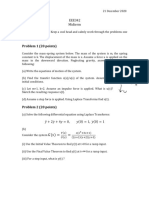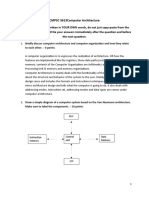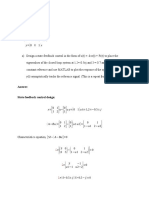Exercise 3 S-DES Usage
Exercise 3 S-DES Usage
Uploaded by
honey arguellesCopyright:
Available Formats
Exercise 3 S-DES Usage
Exercise 3 S-DES Usage
Uploaded by
honey arguellesOriginal Title
Copyright
Available Formats
Share this document
Did you find this document useful?
Is this content inappropriate?
Copyright:
Available Formats
Exercise 3 S-DES Usage
Exercise 3 S-DES Usage
Uploaded by
honey arguellesCopyright:
Available Formats
ID
Exercise 2
AN EXAMPLE OF USING S-DES ALGORITHM
Plaintext (8 bits = 1 byte)
0 1 1 1 1 0 1 1
Key (10 bits)
1 1 0 0 1 1 1 0 1 1
Bit’s operations
(A) permutation P10:
(3 5 2 7 4 10 1 9 8 6)
(B) LS-1 = left shift by 1 for each of 5 bit block separately
(5 2 7 4 3 1 9 8 6 10)
(C) Reducing permutation P8
(6 3 7 4 8 5 10 9)
(D) LS-2 = left shift by 2 for each of 5 bit block separately
(7 4 3 5 2 8 6 10 1 9)
GENERATING THE K1 SUBKEY: operations (A) + (B) + (C)
Operation (A)
0 1 1 1 0 1 1 1 0 1
Operation (B)
1 1 1 0 0 1 1 0 1 1
Operation (C) = subkey K1
1 0 1 0 0 1 1 1
GENERATING THE K2 SUBKEY: operations (A) + (B) + (D) + (C)
Operation (A)
0 1 1 1 0 1 1 1 0 1
Operation (B)
1 1 1 0 0 1 1 0 1 1
Operation (D)
1 0 0 1 1 0 1 1 1 1
Operation (C) = subkey K2
1 0 1 0 0 1 1 1
ENCRYPTION
(1) operation IP (initial permutation) on the plaintext
2 6 3 1 4 8 5 7
1 0 1 0 1 1 1 1
(2) function FKey1() = (() XOR f(, Key1), ())
but f(, Key1) means:
(A’) operation E/P8 (extending permutation) on the first argument of function f
4 1 2 3 2 3 4 1
1 1 1 1 1 1 1 1
(B’) operation (A’) Key1 (XOR)
0 1 0 1 1 0 0 0
(C’) Convert consecutive pairs of bits to decimal numbers. The first pair read as a decimal
specifies the row of table S0, and the third - the row of table S1. The second and fourth binary pairs
analogously determine the column number of tables S0 and S1, respectively. The decimal numbers
read from the tables are again converted to binary notation, obtaining a sequence of 4 bits.
0 1 0 1
Example: we enter (C ') with the bit string 00011100, which converted to decimal numbers give
0, 1 for S0 and 3, 0 for S1. The output produces the string shown in four yellow cells below.
(D’) operation P4 (straight permutation)
2 4 3 1
1 1 1 0
FKey1() = (() XOR (), ())
(3) operation SW (switching halves)
5 6 7 8 1 2 3 4
0 1 0 0 1 1 1 1
(4) function FKey2 () = (() XOR f(, Key2), ())
but f(, Key2) means:
(A’) operation EP (extending permutation) on the first argument of function f
1 1 1 1 1 1 1 1
(B’) operation (A’) Key2 (XOR)
1 0 1 0 0 1 1 1
(C’) do exactly the same as in case of Key1
0 1 1 1
(D’) operation P4 (straight permutation)
2 4 3 1
1 1 1 0
FKey2() = (() XOR (), ())
0 1 0 1 1 0 0 0
(5) operation IP-1 (inverse permutation) = ciphertext
4 1 3 5 7 2 8 6
0 0 0 2 0 0 0 0
You might also like
- WPS656770206OTHDocument27 pagesWPS656770206OTHhoney arguellesNo ratings yet
- LISTENING Level 4 PDFDocument160 pagesLISTENING Level 4 PDFعبدالله العنزيNo ratings yet
- Schedule of Loads and Computation SampleDocument5 pagesSchedule of Loads and Computation SampleVhilly JheykNo ratings yet
- NePA WalkThroughDocument8 pagesNePA WalkThroughvphuc1984100% (1)
- S DesDocument7 pagesS DesYudha RahayuNo ratings yet
- Simplified DES 1: 2.1 Key GenerationDocument3 pagesSimplified DES 1: 2.1 Key GenerationMohammed TawfikNo ratings yet
- Unit IIIDocument55 pagesUnit III20AD022 KAMALI PRIYA SNo ratings yet
- Simpli Ed DES 1: 2.1 Key GenerationDocument3 pagesSimpli Ed DES 1: 2.1 Key GenerationAli hassanNo ratings yet
- Simplified Data Encryption StandardDocument5 pagesSimplified Data Encryption StandardAarindam RainaNo ratings yet
- Simplified DES 1: 2.1 Key GenerationDocument3 pagesSimplified DES 1: 2.1 Key GenerationMohammed YehiaNo ratings yet
- Vitc Bcse309l m2 l2 S DesDocument9 pagesVitc Bcse309l m2 l2 S DesAnime ZNo ratings yet
- Simplified DES 1: 2.1 Key GenerationDocument3 pagesSimplified DES 1: 2.1 Key GenerationRimbun Ferianto SrNo ratings yet
- Ch3.Block CiphersDocument19 pagesCh3.Block CiphersHemant MahajanNo ratings yet
- Simplified DESDocument12 pagesSimplified DESSameh Elnemais100% (1)
- Control Exam 1 SolutionDocument5 pagesControl Exam 1 SolutiongetugaaNo ratings yet
- CHE573 Midterm 2021Document6 pagesCHE573 Midterm 2021John AdjayeNo ratings yet
- Solution To HW9Document11 pagesSolution To HW9Andreina BallunoNo ratings yet
- EngMath (3) 2013 1 HW Chapter6Document3 pagesEngMath (3) 2013 1 HW Chapter6kizito mosesNo ratings yet
- Algoritmul FEALDocument20 pagesAlgoritmul FEALnanacitesteNo ratings yet
- Lewin A., Elliptic Polylogarithms - An Analytic TheoryDocument16 pagesLewin A., Elliptic Polylogarithms - An Analytic TheoryVillebon CharpakNo ratings yet
- Ee304 ADocument3 pagesEe304 AAboo FarisNo ratings yet
- Solution PDFDocument5 pagesSolution PDFCedric SunNo ratings yet
- Step by Step Instruction For Various AlgorithmsDocument4 pagesStep by Step Instruction For Various AlgorithmsSoh Xuan WeiNo ratings yet
- Set No. 1: 4 (Z 1) (Z +1.2z+1) (z+0.1) (Z 0 - 3z+0.8)Document8 pagesSet No. 1: 4 (Z 1) (Z +1.2z+1) (z+0.1) (Z 0 - 3z+0.8)SRINIVASA RAO GANTANo ratings yet
- The Quality or State of Agreeing or Corresponding.a Relation Between Two Numbers Indicatin Gthat The Numbers Give The Same Remainder When Divided by Some Given Number. Compare ResidueDocument22 pagesThe Quality or State of Agreeing or Corresponding.a Relation Between Two Numbers Indicatin Gthat The Numbers Give The Same Remainder When Divided by Some Given Number. Compare ResiduesivaramarajaluNo ratings yet
- Adobe Scan 29 Jan 2024Document25 pagesAdobe Scan 29 Jan 2024Ashlie JaneNo ratings yet
- Lec11 Register Transfer and Micro Operations Part2Document22 pagesLec11 Register Transfer and Micro Operations Part2Diptee KalolaNo ratings yet
- IA2 - QP - DD - 22ECE32 - Ans KeyDocument11 pagesIA2 - QP - DD - 22ECE32 - Ans KeyDeepthi S RNo ratings yet
- S DesDocument5 pagesS DesDimpleNo ratings yet
- ISC 2010 Paper-I Show/Hide Answer: Premium Application SoftwDocument7 pagesISC 2010 Paper-I Show/Hide Answer: Premium Application Softwamit.kstvaNo ratings yet
- Simplified Data Encryption Standard (S-DES)Document12 pagesSimplified Data Encryption Standard (S-DES)karmaelgendy04No ratings yet
- Mid SampleDocument8 pagesMid SampleZahin Tazwar 1921486642No ratings yet
- External-SS-VIMP-Question Bank-2022Document3 pagesExternal-SS-VIMP-Question Bank-2022Fawaaz ShareefNo ratings yet
- SdesDocument13 pagesSdesbharadwaj9522No ratings yet
- One and A Half HoursDocument6 pagesOne and A Half HoursMHUM84No ratings yet
- 2018 April EE307-B - Ktu QbankDocument2 pages2018 April EE307-B - Ktu QbankAdithya Kumar M SNo ratings yet
- A A G G S S DES DES: Ppendix Ppendix Implified ImplifiedDocument4 pagesA A G G S S DES DES: Ppendix Ppendix Implified ImplifiedSkyline VideosNo ratings yet
- Tutorial Sheet 1 Control SystemsDocument7 pagesTutorial Sheet 1 Control SystemsrushilrmalodeNo ratings yet
- Student Solution Chap 05Document6 pagesStudent Solution Chap 05priyapati21No ratings yet
- Impulse Invariance and BilinearDocument8 pagesImpulse Invariance and BilinearAnang MarufNo ratings yet
- Algorithms DPPsDocument17 pagesAlgorithms DPPsSaurabh PeraneNo ratings yet
- Computer 12th 2017Document19 pagesComputer 12th 2017Indumathy SNo ratings yet
- FALLSEM2023-24 BECE202L TH VL2023240102253 2023-10-12 Reference-Material-IDocument5 pagesFALLSEM2023-24 BECE202L TH VL2023240102253 2023-10-12 Reference-Material-Is.sreeram135No ratings yet
- Midterm II SolutionsDocument12 pagesMidterm II SolutionsSSTGingNo ratings yet
- Gate Ece 1999Document8 pagesGate Ece 1999Janmejay OjhaNo ratings yet
- ELE 301: Signals and Systems: Prof. Paul CuffDocument19 pagesELE 301: Signals and Systems: Prof. Paul CuffAaqib Hussain ShahNo ratings yet
- Chapter-1: 1.1 Control Design ProcedureDocument23 pagesChapter-1: 1.1 Control Design ProcedureWildan MumtazNo ratings yet
- Final Exam SampleDocument4 pagesFinal Exam Samplemaithuong85No ratings yet
- (WWW - Entrance-Exam - Net) - IETE AMIETE ET-CS-IT (Old Scheme) Signals and Systems Sample Paper 1Document4 pages(WWW - Entrance-Exam - Net) - IETE AMIETE ET-CS-IT (Old Scheme) Signals and Systems Sample Paper 1Jonas ParreñoNo ratings yet
- Rr411005 Digital Control SystemsDocument8 pagesRr411005 Digital Control SystemsSrinivasa Rao GNo ratings yet
- Some Problems Regarding Bernstein Polynomials: Luciana Lupas 1. K RDocument10 pagesSome Problems Regarding Bernstein Polynomials: Luciana Lupas 1. K RfreghyNo ratings yet
- Interrogation 1 Sujet C - SolutionDocument3 pagesInterrogation 1 Sujet C - Solutioncalabi mozartNo ratings yet
- Data Encryption Standard (Des)Document28 pagesData Encryption Standard (Des)SoohailShaikhNo ratings yet
- TD1 1Document2 pagesTD1 1raïda gcmNo ratings yet
- LaplaceDocument19 pagesLaplaceBlackArmy88No ratings yet
- Signals and Systems2011suppDocument3 pagesSignals and Systems2011suppAnkan BhuniaNo ratings yet
- Numerical Methods For Ode Initial Value ProblemsDocument20 pagesNumerical Methods For Ode Initial Value Problems37 TANNUNo ratings yet
- Homework 1Document1 pageHomework 1alwahedNo ratings yet
- EAC533 - LCS - Assignment I QuestionDocument2 pagesEAC533 - LCS - Assignment I Questionmeseret sisayNo ratings yet
- Experiment 1Document15 pagesExperiment 1RamaDinakaran100% (1)
- University of Lagos Chemical Engineering Department 2019/2020 SESSION, 1st SEMESTERDocument11 pagesUniversity of Lagos Chemical Engineering Department 2019/2020 SESSION, 1st SEMESTERAanu OlumuyiwaNo ratings yet
- Crypto U-2Document55 pagesCrypto U-2guruvarshniganesapandiNo ratings yet
- Cse 205: Digital Logic Design: Dr. Tanzima Hashem Assistant Professor Cse, BuetDocument55 pagesCse 205: Digital Logic Design: Dr. Tanzima Hashem Assistant Professor Cse, BuetShakib AhmedNo ratings yet
- 643 Cumulative Online AssignmentDocument2 pages643 Cumulative Online Assignmenthoney arguellesNo ratings yet
- 15067CEM ResitDocument20 pages15067CEM Resithoney arguellesNo ratings yet
- Task 1Document12 pagesTask 1honey arguellesNo ratings yet
- EM202358SOP327PMDocument6 pagesEM202358SOP327PMhoney arguellesNo ratings yet
- Introductio 1Document26 pagesIntroductio 1honey arguellesNo ratings yet
- Action Plan Review FormDocument2 pagesAction Plan Review Formhoney arguellesNo ratings yet
- WPS658943103WR Copy2Document5 pagesWPS658943103WR Copy2honey arguellesNo ratings yet
- LA023647 Assn5 Answer Sheet CPCCBC4010B UNGRADED Ed1Document14 pagesLA023647 Assn5 Answer Sheet CPCCBC4010B UNGRADED Ed1honey arguellesNo ratings yet
- Assessment 2 Written AssessmentDocument4 pagesAssessment 2 Written Assessmenthoney arguellesNo ratings yet
- 519-Article Text-1465-1-10-20210620Document8 pages519-Article Text-1465-1-10-20210620honey arguellesNo ratings yet
- Assessment 1 Reflective JournalDocument12 pagesAssessment 1 Reflective Journalhoney arguellesNo ratings yet
- Assessment 1 Ethical Dilemmas AnalysisDocument20 pagesAssessment 1 Ethical Dilemmas Analysishoney arguellesNo ratings yet
- EM23TOP2503AEAM UpadtedDocument13 pagesEM23TOP2503AEAM Upadtedhoney arguellesNo ratings yet
- Intertextuality Contemporary Analysis PaperDocument5 pagesIntertextuality Contemporary Analysis Paperhoney arguellesNo ratings yet
- Architecture 2020Document10 pagesArchitecture 2020honey arguellesNo ratings yet
- Archi ToolDocument24 pagesArchi Toolhoney arguellesNo ratings yet
- AccountingDocument14 pagesAccountinghoney arguellesNo ratings yet
- AnswersDocument11 pagesAnswershoney arguellesNo ratings yet
- Action Plan Review FormDocument2 pagesAction Plan Review Formhoney arguellesNo ratings yet
- Consider The SystemDocument8 pagesConsider The Systemhoney arguellesNo ratings yet
- Final FileDocument17 pagesFinal Filehoney arguellesNo ratings yet
- Order 3280820 FinalDocument12 pagesOrder 3280820 Finalhoney arguellesNo ratings yet
- EM202260TOP824MTLDocument5 pagesEM202260TOP824MTLhoney arguellesNo ratings yet
- Diversification Discount On Firm ValueDocument33 pagesDiversification Discount On Firm Valuehoney arguellesNo ratings yet
- 2 TG76HIK23MAT 1assignment2Document1 page2 TG76HIK23MAT 1assignment2honey arguellesNo ratings yet
- EM202257CON1014CHMDocument8 pagesEM202257CON1014CHMhoney arguellesNo ratings yet
- 4CS001 Python Workshop 4: Control Structures: Note Down The Response To Each. Do They Differ From What You Would Expect?Document5 pages4CS001 Python Workshop 4: Control Structures: Note Down The Response To Each. Do They Differ From What You Would Expect?honey arguellesNo ratings yet
- Dataset - Data AnalyticsDocument198 pagesDataset - Data Analyticshoney arguellesNo ratings yet
- DarftDocument12 pagesDarfthoney arguellesNo ratings yet
- DurosealDocument8 pagesDurosealqsdpfyb2c5No ratings yet
- PROFS DATABASEDocument35 pagesPROFS DATABASEadityabiswas2911No ratings yet
- Theories of Corporate PersonalityDocument4 pagesTheories of Corporate PersonalityAman TiwariNo ratings yet
- Sample Consent and Interview GuideDocument16 pagesSample Consent and Interview GuideMarjorie CrisologoNo ratings yet
- C K PrahaladDocument6 pagesC K Prahaladmanoogn1642No ratings yet
- Describing GraphDocument20 pagesDescribing GraphGita RahMaNo ratings yet
- Fashion Photography ThesisDocument5 pagesFashion Photography Thesisgj9cpzxs100% (2)
- Educational Resume 2021Document2 pagesEducational Resume 2021api-275638156No ratings yet
- A330 Instructor HandbookDocument202 pagesA330 Instructor HandbookPunthep Punnotok100% (2)
- Buried Pipe NDTDocument224 pagesBuried Pipe NDTDemian PereiraNo ratings yet
- Starting & Charging System: QG18DE SR20DEDocument20 pagesStarting & Charging System: QG18DE SR20DEJorge CabreraNo ratings yet
- Made Easy Ce Set A 2019 PDFDocument75 pagesMade Easy Ce Set A 2019 PDFRaj Kumar AshishNo ratings yet
- Standards As Reference To Build A PHM-Based SolutionDocument9 pagesStandards As Reference To Build A PHM-Based SolutionJosé Carlos Dias FilhoNo ratings yet
- Corporate Swift Connectivity: Eurofinance MiamiDocument47 pagesCorporate Swift Connectivity: Eurofinance MiamiPatrick Peters BuhlerNo ratings yet
- Knee Type Milling MachinesDocument6 pagesKnee Type Milling MachinesArchit Jhunjhunwala100% (1)
- Busch R 5 RA 0165, 0205, 0255, 0305 DDocument20 pagesBusch R 5 RA 0165, 0205, 0255, 0305 DEduardo Efrain Rubio100% (2)
- Manual Valvula BaccaraDocument2 pagesManual Valvula BaccaraAna Joselyn Tello MuñozNo ratings yet
- Unit 1 HandoutDocument13 pagesUnit 1 HandoutririNo ratings yet
- 114.E-SHOT Issue 114 - September 2020Document52 pages114.E-SHOT Issue 114 - September 2020olimpio.braga.salesmanagerNo ratings yet
- Terry Carr Dance of The Changer The ThreeDocument11 pagesTerry Carr Dance of The Changer The ThreeMmm Bbb100% (1)
- York Product Listing 2011Document49 pagesYork Product Listing 2011designsolutionsallNo ratings yet
- FX Smile ModellingDocument5 pagesFX Smile ModellingCygwin KapNo ratings yet
- Team Exercise How Parenting Styles Affect The NextDocument7 pagesTeam Exercise How Parenting Styles Affect The NextTamta SaamishviliNo ratings yet
- Treatment in Schizophrenia: Factors For Adherence: Francisca Caiado de BragançaDocument39 pagesTreatment in Schizophrenia: Factors For Adherence: Francisca Caiado de BragançaArif IrpanNo ratings yet
- Powerchain CP Cable: Application StandardsDocument2 pagesPowerchain CP Cable: Application StandardsRuben Checalla RamosNo ratings yet
- Online Financial Services 2 PDFDocument1 pageOnline Financial Services 2 PDFanisNo ratings yet
- Aqar 2018 19Document154 pagesAqar 2018 19Zoeb MerchantNo ratings yet






















































































































